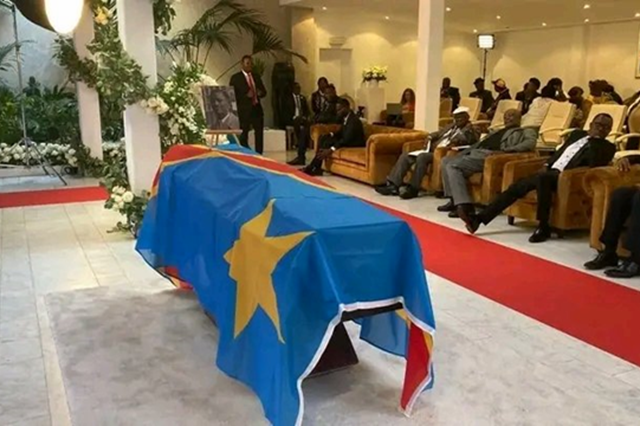Kisangani – After resting in his native village, the coffin of the former Belgian Congo’s first post-independence prime minister on Friday pursued its memorial pilgrimage to the northeastern city of Kisangani.
As in Onalua village in the centre of today’s Democratic Republic of Congo, where Patrice Lumumba was born in 1925, officials, dancers and tam-tams in Kisangani awaited the remains of the independence hero, executed in January 1961, four months after the end of his brief term in office.
A single tooth is all that remains of the young scholar and nationalist politician whose life and career was cut short in a dark struggle for leadership and control of resources in the central African country.
This what remained of Patrice Lumumba, his gold-capped tooth, returned to his family in DRC – 61 years after he was murdered and dissolved in acid. DRC has never known peace since that day. These are the criminals who want to lecture us about Human Rights today pic.twitter.com/NrYCSa9UUw
— African (@ali_naka) June 20, 2022
ALSO READ | Old friend blames UN, Belgium for the killing of Congolese hero Lumumba
His body was dissolved in acid after he was killed, but a Belgian police officer kept the tooth as a trophy. Belgian authorities 2016 seized the relic from his daughter.
Belgium finally returned it on Monday to Lumumba’s family members during a ceremony in Brussels.
It was then placed inside a coffin for the funeral tour, 61 years late.
‘I protect Lumumba’s chair’
In a small room inside a brick building known as “1925” in Kisangani, the shelves are stacked with records and works of the colonial administration in Stanleyville, as Kisangani used to be called.
Titles ranged from “Congo Codes and Laws, 1954” and “Legal Review of the Belgian Congo” to “Palm groves in relation to ethnology”.
Lumumba worked here as a librarian for the Indigenous Labour Administration. He was also in charge of mail at the Post Office.
Joseph Lifaefi, head of an office that watches over the property, says he has heard talk of “a tourist site, but nothing concrete”.
“I protect Lubumba’s table and chair, the writings with his signature, his demands,” he told AFP, showing the wooden chair and old grey table.
ALSO READ | Remains of independence hero Lumumba arrive home in DRC
He voiced concern for precious documents, some of which date back to the 19th century, that he said should be digitised.
“This makes me feel ashamed,” Lifaefi said. “There should be a museum here.”
Lumumba was just 20 when he arrived in Stanleyville, a junior civil servant appointed to handle postal cheques. He went on to become the commercial director of a large brewery.
“My father was the first to welcome him,” said Pauline Kimbulu, daughter of Paul Kimbulu, one of the few qualified nurses from colonial days.
“He came to eat here,” Kimbulu added in front of a small home with cement walls and a tin roof.
“Let someone restore this house.”
‘Extreme ambition’
ALSO READ | Fraught ties between DRC and Rwanda date back decades
As years passed, Lumumba gained confidence and “strength of conviction” matched with eloquence and easy charm, according to Belgian cultural historian and journalist David Van Reybrouck in his prize-winning work “Congo, the Epic History of a People”.
He lived until the late 1950s in Commercial District Five, where little tarmac remains on his street and the electricity supply died two years ago.
He held meetings at the mythical “Circle of State of Mangobo”, a hall that is now a ramshackle depot for furniture and coffins for sale.
Leader of a trade union branch, head of a local association of “evolved” minds, and author of political analyses and newspaper columns, Lumumba also possessed what Van Reybrouck described as “extreme ambition”.
In 1958 he launched a political party, the Congolese National Movement (MNC), which won national elections in May 1960, a month before independence.
‘Fixing the road’
Blaise Tresor Badjoko, a neighbour, says that his father came to live in Lumumba’s home after his execution, and died under the same roof. Badjoko believes that Lumumba’s remains should rest in Kisangani, rather than in the capital Kinshasa.
After speeches on Friday in front of the coffin, four activists from the Lucha rights group burst out of the crowd holding up cardboard signs.
Bruh, Belgium returns Patrice Lumumba’s tooth DRC 61 years later after his murder. pic.twitter.com/WsKyTFyljm
— Tellaman (@Tellamahn) June 20, 2022
ALSO READ | WATCH | Remains of independence hero Lumumba return to DRC
“Honouring Lumumba” meant setting up a “mausoleum in Kisangani”, but also “fixing the road” leading to his former home and “ensuring the territorial integrity of Congo as it is threatened by Rwanda”, they read.
The anti-colonial icon’s return home comes as the DRC has accused neighbouring Rwanda of backing rebels in the country’s east, a charge Kigali has denied.
From Kisangani, the coffin will be taken on Sunday to Katanga in the southeast, where a secessionist movement raged after independence and where Lumumba and his aides were tortured.
The burial ceremony in Kinshasa is planned for June 30, which is Independence Day.
Follow African Insider on Facebook, Twitter and Instagram
Source: AFP
Picture: Twitter/@Poluoch
For more African news, visit Africaninsider.com


